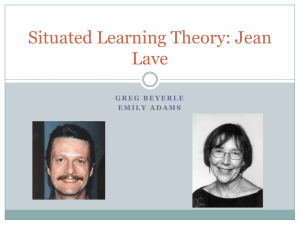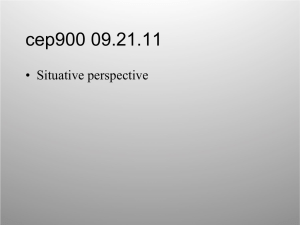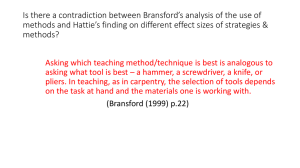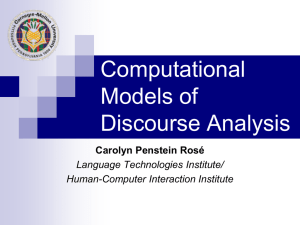Situated learning assignment & test item bank
advertisement
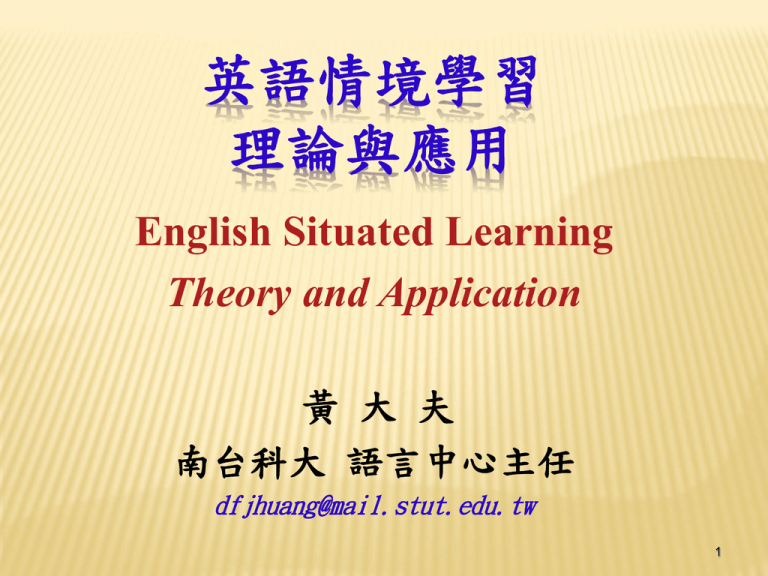
英語情境學習 理論與應用 English Situated Learning Theory and Application 黃 大 夫 南台科大 語言中心主任 dfjhuang@mail.stut.edu.tw 1 OUTLINE • • • • • • Introduction Theories of situated learning/teaching Characteristics of authentic activities Instructional design for SL activities Application and practice of SL Conclusion 2 INTRODUCTION (1/4) 社會建構理論架構 (Oliver, 1999) INTRODUCTION (2/4) • • • • The problems/phenomena situated learning attempts to address (Brown, Collins and Dugid, 1989): There is a mismatch between the learning situation in school and the real world situations There is a failure of knowledge to transfer Training by abstraction is of little use Learning is inherently a social phenomena 4 INTRODUCTION (3/4) • • • • Situated learning : as a model of learning in a community of practice (實務社群) projected by J. Lave and E. Wenger SL allows individuals to learn by socialization, visualization, and imitation Learning begins with people trying to solve problems Skills are acquired through authentic contexts and by communicating with peers and experts about those contexts 5 INTRODUCTION (4/4) • • • • Knowledge is located in the actions of persons and groups Knowledge evolves as individuals participate in and negotiate their way through new situations Knowing, learning and cognition are social constructions, expressed in actions of people interacting within communities Construction of meaning is tied to specific contexts and purposes 6 THEORIES OF SITUATED LEARNING/TEACHING (1/7) Cognition (情境認知) Cognitive Apprenticeships (認知學徒;養成訓練) Legitimate peripheral participation (周邊參與) Situated • • Learning is naturally tied to authentic activity, context, and culture Cognitive apprenticeship provides practical steps for applying situated cognition. 7 THEORIES OF SITUATED LEARNING/TEACHING (2/7) Situated Cognition (Brown, Collins, & Duguid, 1989) • Learning is an enculturation process Learning is a continuous, lifelong process from acting in situations Knowledge, as a product of a meaning-making process, cannot be separated from the context of its use. 學習是透過個體在參與活動中的社會互動與協作 學習來融入並適應群體的文化(enculturation; 涵化),而知識是在學與用的真實活動 (authentic activity)情境中認知的,並非獨 立於情境外獨立形成的抽象概念 • • • 8 THEORIES OF SITUATED LEARNING/TEACHING (3/7) • • Cognitive apprenticeship (Brown, Collins, & Duguid, 1989) : four strategies to engage students to participate in a community of practice By beginning with a task embedded in a familiar activity it shows the students the legitimacy of their implicit knowledge and its availability as scaffolding in apparently unfamiliar tasks By pointing to different decompositions it stresses that heuristics are not absolute but assessed with respect to a particular task 9 THEORIES OF SITUATED LEARNING/TEACHING (4/7) Cognitive apprenticeship: • By allowing students to generate their own solution paths, it helps make them conscious creative members of the culture of problemsolving mathematicians. By enculturating students through this activity, it helps them acquire some of the culture‘s tools--a shared vocabulary and the means to discuss, reflect upon, evaluate and validate community procedures in a collaborative process. • 10 THEORIES OF SITUATED LEARNING/TEACHING (5/7) 認知學徒制為「做中學」學習模式最早形式 認知學徒制從四面向提出教學策略,構建有 效教學環境: 呈現內容方式:1.概念、事實或程序 2.提供解決 問題的經驗策略 3.控制/復原策略 4.學習策略 刺激認知教學:1.模仿 2.輔導 3.鷹架的提供或重 組 4.給予獲新知機會 5.反思 6.鼓勵探究能力 教學內容排序方式:1.增加內容複雜程度 2.增加 內容的多樣性 3.分解技能前呈現整體的技能 學習社會化教學:1.情境學習 2.模擬 3.專家實踐 的文化群體 4.內在動機 5.利用合作 11 THEORIES OF SITUATED LEARNING/TEACHING (6/7) Legitimate peripheral participation (Lave, 1988, Lave & Wenger, 1991): • • Process of how a learner engages in the activity of a sociocultural practice and becomes increasingly competent in this practice. Participation provides students to define ways of belonging to a community of practice. 12 THEORIES OF SITUATED LEARNING/TEACHING (7/7) Legitimate peripheral participation (Lave, 1988, Lave & Wenger, 1991): • • • • Legitimate refers to social organization of and control over resources of the practice Peripheral is used to distinguish between new comers and old timers 學徒透過實際工作實踐並學習師傅的教導,依循 「合法周邊參與」到「充分參與」的社會化演進 歷程(從外行人到成為圈內人),透過社會實踐 的參與學習,提升個體參與實務活動的能力 工作、生活、學習就在同一個情境裡,是個人、 行為、環境緊密結合為一的現實事務,稱之為 「實務社群」(Community of Practice;CoP) 13 CHARACTERISTICS OF AUTHENTIC ACTIVITIES (REEVES ET AL, 2002) 14 INSTRUCTIONAL DESIGN FOR SL ACTIVITIES (1/6) • • • • Provide authentic context that reflect the way the knowledge will be used in real-life Provide multiple, authentic and motivating activities Provide access to expert performances and the modeling of processes Provide multiple roles and perspectives 15 INSTRUCTIONAL DESIGN FOR SL ACTIVITIES (2/6) • • • • Provide practices and training sessions Support collaborative construction of knowledge Provide coaching and scaffolding at critical times Promote reflection to enable abstractions to be formed 16 INSTRUCTIONAL DESIGN FOR SL ACTIVITIES (3/6) • • • • Promote answer finding and problem solving Promote articulation to enable tacit knowledge to be made explicit Provide for integrated assessment of learning within the tasks Provide use of technology/media/tools 17 INSTRUCTIONAL DESIGN FOR SL ACTIVITIES (4/6) • • Young (1993): four tasks for the design of situated learning: Selecting the situation: select the generator set of situations, which entail complex, realistic problem spaces that afford students to be able to detect the invariant concepts in the domain Providing scaffolding: students generate problems and solutions to "crisscross the landscape of knowledge". Limit initially a novice's access to all the features of the context and then remove those constraints." 18 INSTRUCTIONAL DESIGN FOR SL ACTIVITIES (5/6) • Determining/supporting the role of the teacher: Teachers assess the interaction of students and the environment and guide students to pay attention to important attributes of the environment • Assessing situated learning: • • • The assessment methods should focus on "the process of learning, perception, and problem solving." Assessment must become an integrated, ongoing, and seamless part of the learning environment Assessment must provide important feedback to both teacher and students 19 INSTRUCTIONAL DESIGN FOR SL ACTIVITIES (6/6) INTERACTIVE MULTIMEDIA (Herrington & Oliver, 2000) APPLICATION AND PRACTICE OF SL • • • • • • Teaching methods Curricular design English learning environment English SL rooms Field trips International English Village 21 TEACHING METHODS Wang (2009) • Multimedia use • Games (guessing, etc.) • Role playing/reader theater • Association • Mind mapping • Story telling • Realia • Rhyming Songs 22 CURRICULAR DESIGN CURRICULAR DESIGN • • Linking with learning objectives Informal as well as formal learning • • • • • • Live DVD in computer/language labs Outdoor English environment English corner Profiling and recording situated learning activity procedures English situated activity guidebooks & self-practice handouts/e-platform Oral SL assessment e-platform 23 LiveDVD Learning System Oral Situated Practice & Assessment e-platform 25 Situated learning assignment & test item bank (1/5) • Giving English situated assignments • Individual/group work uploaded in audio/video files or via hyperlink 1 2 可上傳音檔/影片檔 /網路超連結 26 Situated learning assignment & test item bank (2/5) 3 • Online oral test item bank • test item for group interaction situation 27 老師端 learning assignment & test item bank (3/5) Situated 4 Checking status of assignment submission 點開可看學生繳交 狀況並進行評分 28 Situated learning assignment & test item bank (4/5) 5 • Viewing, listening, and scoring of oral assignments • Comments on students’ works 29 Situated learning assignment & test item bank (5/5) Score report of student oral practice achievement 6 30 SETTING UP ENGLISH ENVIRONMENT • • • • • • • • • English corner Fitted into course content Fitted into current festivals Characterizing authentic events Hands-on participation of students Highlighting school features Team work competition Faculty & Staff English contests English day 31 ENGLISH SITUATED LEARNING ROOMS • Physical setup: realia or visual reproduction • • • • • Second -year learning activities at TNRHES Third/fourth-year learning activities Sixth-year learning activities Sixth-year learning activities Computerized setup: virtual situations via panorama facilities 32 利用電腦週邊產品照片,介紹用英文分辨相關電腦設備 利用台南市地圖,介紹如何用英文口說介紹目前的方位 利用餐點的菜單,及點餐小短片讓學生學習用英文點餐 利用各地美景圖片,讓學生用英文描述照片的自然景觀 利用大學生在校生活的照片,讓學生英文自我介紹 挑選幾部有名的影片,讓學生學習如何用英文簡略描述影 片內容 在聽完一段對話後,透過圖片及題目問答方式,讓學生分組討論, 並由各組派代表上台分享各組的討論心得 選取幾張藝術照片,讓學生學習如何用英文表達色調及喜好 利用國外照片及地圖做結合,介紹如何用英文分辨方位 選取各款式顏色衣服,讓學生學習如何用英文表達顏色及衣服名稱 FIELD TRIPS • • • Participant-observer studies in an organic farm, aquarium, botany, museum, theme parks, etc. Learning themes and tasks well planned and embedded into course objectives English summer/winter camps • 43 INTERNATIONAL ENGLISH VILLAGE 44 • • • • • • • • CONCLUSION 中小學情境英語教學成效關鍵 英語情境學習理論實務正確認知 學校當局展現推動企圖心與決心 教育當局行政充足支援與協調 針對各校本身特色與資源,佈局開發英語情境學 習與擬定通盤發展計畫 (Megaplan) 教師英語情境活動設計與執行品保、評量與成效 追蹤機制建立 確保英語教師熱忱、專業素養、自我提升動機 定期成果展示與校際交流,永續提升教學成效 提升全校教職員英語能力;學生英文能力提升, 人人是關鍵,人人有責任 45 Thank you! 46 REFERENCES (1/3) Barab, S.A., Squire, K.D., & Dueber, W. (2000). A co-evolutionary model for supporting the emergence of authenticity. Educational Technology Research and Development, 48(2), 37-62. Bottge, B.A., & Hasselbring, T.S. (1993). Taking word problems off the page. Educational Leadership, 50(7), 36-38. Bransford, J.D., Sherwood, R.D., Hasselbring, T.S., Kinzer, C.K., & Williams, S.M. (1990). Anchored instruction: Why we need it and how technology can help. In D. Nix & R. Spiro (Eds.), Cognition, education and multimedia: Exploring ideas in high technology (pp. 115141). Hillsdale, NJ: Lawrence Erlbaum. Bransford, J.D., Vye, N., Kinzer, C., & Risko, V. (1990). Teaching thinking and content knowledge: Toward an integrated approach. In B.F. Jones & L. Idol (Eds.), Dimensions of thinking and cognitive instruction (pp. 381-413). Hillsdale, NJ: Lawrence Erlbaum Associates. Brown, J.S., Collins, A., & Duguid, P. (1989). Situated cognition and the culture of learning. Educational Researcher, 18(1), 32-42. Cognition and Technology Group at Vanderbilt. (1990a). Anchored instruction and its relationship to situated cognition. Educational Researcher, 19(6), 2-10. Cognition and Technology Group at Vanderbilt. (1990b). Technology and the design of generative learning environments. Educational Technology, 31(5), 34-40. Collins, A., Brown, J. S., & Newman, S. E. (1990). Cognitive apprenticeship: Teaching the crafts of reading, writing, and mathematics. In L. B. Resnick (Ed.), Knowing, learning, and instruction: Essays in honor of Robert Glaser (pp. 453-494). Hillsdale, NJ: Lawrence Erlbaum. 47 REFERENCES (2/3) Cronin, J.C. (1993). Four misconceptions about authentic learning. Educational Leadership, 50(7), 78-80. Duchastel, P.C. (1997). A Web-based model for for university instruction. Journal of educational technology systems, 25(3), 221-228. Gordon, R. (1998). Balancing real-world problems with real-world results. Phi Delta Kappan, 79, 390-393. Herrington, J., & Herrington, A. (1998). Authentic assessment and multimedia: How university students respond to a model of authentic assessment. Higher Education Research and Development, 17(3), 305-322. Jonassen, D. (1991). Evaluating constructivistic learning. Educational Technology, 31(9), 28-33. Lave, J. (1988). Cognition in practice: Mind, mathematics, and culture in everyday life. Cambridge, UK: Cambridge University Press. Lave, J., & Wenger, E. (1991). Situated learning: Legitimate peripheral participation. Cambridge: Cambridge University Press. Lebow, D., & Wager, W.W. (1994). Authentic activity as a model for appropriate learning activity: Implicationsfor emerging instructional technologies. Canadian Journal of Educational Communication, 23(3), 231-144. Myers, S. (1993). A trial for Dmitri Karamazov. Educational Leadership, 50(7). Oliver, R., & Omari, A. (1999). Using online technologies to support problem based learning: Learners responses and perceptions. Australian Journal of Educational Technology, 15(15879). 48 REFERENCES (3/3) Reeves, T.C., Herrington, J., & Oliver, R. (2002). Authentic activities and online learning. In A. Goody, J. Herrington & M. Northcote (Eds.), Quality conversations: Research and Development in Higher Education, Volume 25 (pp. 562-567). Jamison, ACT: HERDSA. Reeves, T.C., & Okey, J.R. (1996). Alternative assessment for constructivist learning environments. In B.G. Wilson (Ed.), Constructivist learning environments: Case studies in instructional design (pp. 191-202). Englewood Cliffs, NJ: Educational Technology Publications. Resnick, L. (1987). Learning in school and out. Educational Researcher, 16(9), 13-20. Sternberg, R.J., Wagner, R.K., & Okagaki, L. (1993). Practical intelligence: The nature and role of tacit knowledge in work and at school. In J.M. Puckett & H.W. Reese (Eds.), Mechanisms of everyday cognition (pp. 205-227). Hillsdale, NJ: Lawrence Erlbaum Associates. Wang, R.-K. (2009). Application of situated learning in elementary school English teaching. Taipei County Education, 69(87-91). Winn, W. (1993). Instructional design and situated learning: Paradox or partnership. Educational Technology, 33(3), 16-21. Young, M.F. (1993). Instructional design for situated learning. Educational Technology Research and Development, 41(1), 43-58. Young, M.F. (1995). Assessment of situated learning using computer environments. Journal of Science Education and Technology, 4(1), 89-96. Young, M.F., & McNeese, M. (1993). A situated cognition approach to problem solving with implications for computer-based learning and assessment. In G. Salvendy & M.J. Smith (Eds.), Human-computer interaction: Software and hardware interfaces. New York: Elsevier Science Publishers. 49
